As we made ready to leave Harlingen, a Dutch man came over to have a chat with me. From our discussion I learned why water was streaming past us. "Periodically, by use of locks, the water authorities allow water to flow through the town canals. This circulation helps to flush the canals out," he informed me. He and his wife intended to sail to the islands today. He was very knowledgeable about the tides, suggesting when the best time would be to travel down to the Ijsselmeer. Rex had already done his homework and knew the optimum time, but we wanted to set off early in order to have time for a look around the small town of Hindeloopen.
"We have sailed to England many times," he informed us, "it can be very expensive there." "It certainly is on the south coast," I replied. Rex piped in, "In Croatia, they will charge you Euros 50 just to tie up to the quayside. It is full of Russian sailors down there." The chap laughed. "We have visited the east of England too: Lowestoft, Southwold, the Orwell and Deben and the Blackwater. I have even been to Tollesbury," he added.
"There is a 100 feet sailing boat, and a very large motor boat over in the shipyard," he informed us, nodding in the direction of the yard. "We saw a boat yard over in Makkum," I told him. "We were told the large boats there cost 1 million Euros/metre length." The bloke smiled, "Donald Trump once owned that yard. The yard was building a large boat for him, and it went bankrupt. Trump then bought the yard, and kept it going so that his boat would be finished. When it was completed, apparently he bought everyone in the town a drink. Then he sold the boat yard."
The discussion moved on to the architectures in this part of the world. "A lot of the ports from Hamburg to Tallin have similar architectural features," he stated. "They all belonged to the Hanseatic League. Holland is famous for its trading, and the VOC (Dutch East India Company) is well known. But I believe the trade with the Baltic was much more important." "Really, what was being traded?" I enquired. "We took a lot of salt from the UK and southern Europe to the Baltic, and brought back a lot of timber. They were small boats, only 100 feet long."
 A Long Way to Row to Vlieland |
We slowly entered the colossal marina, creeping slowly past the harbour master's office. We could not pull in since the staging was full of craft tied up to pay their marina dues. I spotted two lads marching up and down the staging, who appeared to be associated with the office. I managed to establish eye contact with one of them, and shouted across, "Heb je een ligplaats. Onze boot is 8,8 m lang en 3,3 m breed?" He ran into the office, and shortly reappeared shouting, "Nummer 20. Om de hoek en aan de linkerkant." "Dank u wel!" I shouted back, and we crept around the corner of the staging and soon located berth number 20. Rex expertly guided us in. I got the stern ropes on the two piles as we passed them, then dashed up to the bow to sort out the two lines there. A fellow from an adjacent boat kindly took our bow lines and fed them back to me. We were soon moored safely. The kind guy also passed the hosepipe he had been using across to us - must be Stay Kind to the Brexit Crowd Week.
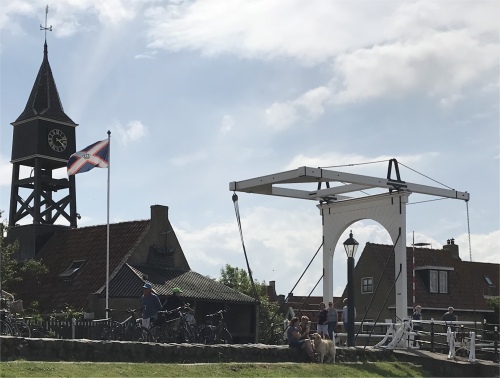 Leaf Bridge |
We headed off for a stroll around the small, pretty town, bringing back fond memories of our stay here in 2015. We passed the small but busy Hylper Haven Marina (Hindeloopen Frisians were natively called Hylpers), the Sylhuis, the lockkeeper's house, together with the leaf bridge in front of it, and the Liars' Bench, where male inhabitants of Hindeloopen still meet and tell tall stories.
Hindeloopen received city rights in 1225, and in 1368 it became a member of the Hanseatic League. Since the 12th and 13th centuries, Hindeloopen trading vessels undertook journeys to the North and Baltic Sea Coasts. The strong overseas connections with foreign countries and infrequent contact with the hinterland were probably the reasons for the development of the Hindeloopen language; a mixture of West Frisian, English, Danish, and Norwegian.
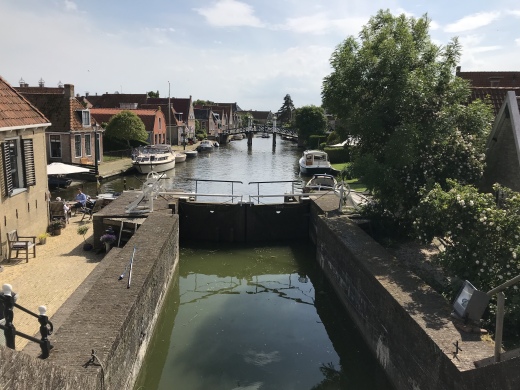 De Zijlroede from the Leaf Bridge |
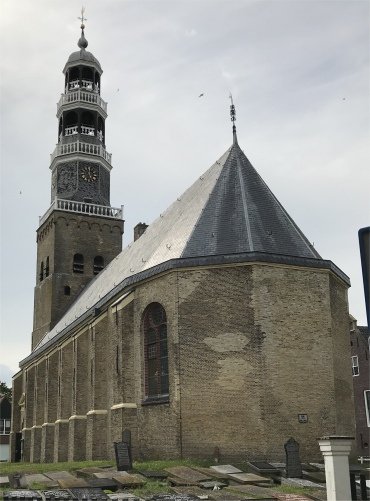 Grote Kerk |
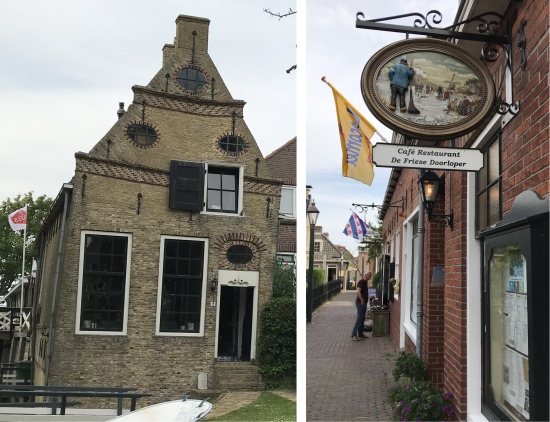 17th Century Sea Captain's House and Pancake Cafe |
Moving on we came across the Frisian Skating Museum. I understood the museum itself contained a large collection of skates, slides, old prints and an Elfsteden history with many photos. We decided not to enter, but the shop that fronted it was a treasure house full of painted clogs (Klompen), trays and bric-a-brac; spell-binding.
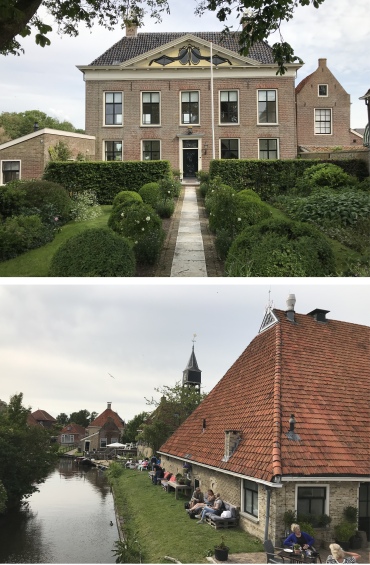 Varied Architectures |
We dined in the town in the evening at the Visrestaurant Sudersee, two Britons among a sea of Germans. We retired early; poor Rex had stomach ache.
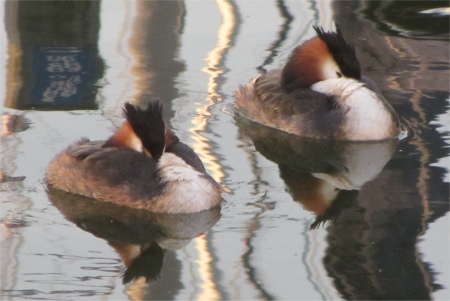 Pair of Grebes |
